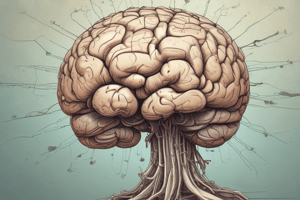Podcast
Questions and Answers
Anatomy 211B likely covers the entirety of human anatomy, from basic structures to advanced systems.
Anatomy 211B likely covers the entirety of human anatomy, from basic structures to advanced systems.
False (B)
Which of the following is NOT a likely topic covered in Anatomy 211B?
Which of the following is NOT a likely topic covered in Anatomy 211B?
- Cardiovascular Anatomy: Detailed structure of the heart, blood vessels, and associated lymphatic structures, focusing on blood flow, circulation, and related pathologies.
- Introductory Human Anatomy: Basic structures and systems relevant to human biology. (correct)
- Digestive Anatomy: Detailed microscopic and macroscopic structures of the gastrointestinal tract, including accessory organs, and the digestive process.
- Neuroanatomy: Specific regions of the brain and spinal cord, neural pathways, neurotransmitters, and neurological disorders.
A key learning outcome of Anatomy 211B is for students to master ______ crucial for communication in medical settings.
A key learning outcome of Anatomy 211B is for students to master ______ crucial for communication in medical settings.
anatomical terminology
What is the significance of understanding the clinical implications of anatomical structures and processes?
What is the significance of understanding the clinical implications of anatomical structures and processes?
Match the following anatomical areas with their potential associated pathologies:
Match the following anatomical areas with their potential associated pathologies:
Which of the following is NOT a typical learning activity in Anatomy 211B?
Which of the following is NOT a typical learning activity in Anatomy 211B?
Anatomy 211B emphasizes memorization of anatomical structures and functions, with little focus on their practical applications.
Anatomy 211B emphasizes memorization of anatomical structures and functions, with little focus on their practical applications.
Why is it important for students in Anatomy 211B to develop a deep understanding of structural relationships between different anatomical systems?
Why is it important for students in Anatomy 211B to develop a deep understanding of structural relationships between different anatomical systems?
Flashcards
Neuroanatomy
Neuroanatomy
The study of brain regions, spinal cord, and neural pathways.
Cardiovascular Anatomy
Cardiovascular Anatomy
The structure of the heart, blood vessels, and lymphatic systems.
Respiratory Anatomy
Respiratory Anatomy
Study of the lungs, respiratory passages, and breathing mechanics.
Digestive Anatomy
Digestive Anatomy
Signup and view all the flashcards
Urinary Anatomy
Urinary Anatomy
Signup and view all the flashcards
Endocrine Anatomy
Endocrine Anatomy
Signup and view all the flashcards
Musculoskeletal Anatomy
Musculoskeletal Anatomy
Signup and view all the flashcards
Clinical Significance
Clinical Significance
Signup and view all the flashcards
Study Notes
Course Overview
- Anatomy 211B likely focuses on a specific area of anatomy beyond basic human anatomy.
- The course builds upon prior knowledge, delving into specialized systems or regions.
- Content is highly detailed, emphasizing intricate structures and relationships.
- Course covers associated terminology, functions, and clinical implications.
Potential Course Topics (Illustrative)
- Neuroanatomy: Specific regions of the brain and spinal cord, neural pathways, neurotransmitters, and neurological disorders.
- Cardiovascular Anatomy: Detailed structure of the heart, blood vessels, and lymphatic structures, focusing on blood flow, circulation, and related pathologies.
- Respiratory Anatomy: Specific lung and respiratory passage compartments, breathing mechanisms, and respiratory-circulatory relationships.
- Digestive Anatomy: Detailed microscopic and macroscopic structures of the gastrointestinal tract, including accessory organs, and the digestive process.
- Urinary Anatomy: Anatomical structures and functions of the urinary system (kidneys, ureters, bladder, urethra), emphasizing urine production and excretion.
- Endocrine Anatomy: Glandular structures, hormones, effects on body systems, and feedback control mechanisms, including pathologies.
- Musculoskeletal Anatomy (Specific): Specific skeletal regions, muscle groups, or joint systems, focusing on movement and integrated function.
Expected Learning Outcomes
- Students gain a detailed understanding of the selected anatomical topic.
- Students master anatomical terminology for medical communication.
- Students develop an in-depth understanding of structural relationships between anatomical systems.
- Students understand the clinical significance and practical implications of studied structures and processes.
- Students develop proficiency in applying anatomical knowledge to case studies and clinical scenarios.
Potential Learning Activities
- Dissections (if applicable).
- Laboratory exercises and practicals.
- Case studies and clinical scenarios.
- Lectures, presentations, and discussions.
- Visual aids (e.g., anatomical models, diagrams).
- Anatomical imaging.
- Group work and problem-solving exercises.
Studying That Suits You
Use AI to generate personalized quizzes and flashcards to suit your learning preferences.




